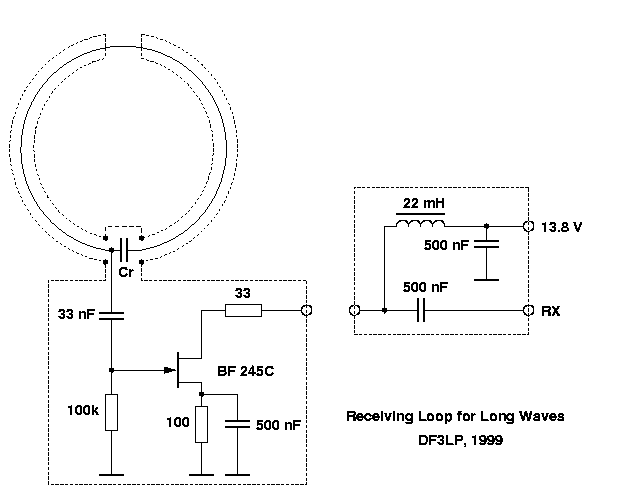
One major problem receiving long waves (e.g. 137 kHz ham band) is the presence of local noise sources. Here in North Germany all faint amateur signals on 137 kHz are covered by a curtain of LORAN-C sidebands from the island of SYLT (120 km NW from this site).
So I decided to erect an antenna which is able to cancel out this unwanted source. One possible answer is to build a magnetic receiving loop. "Magnetic" means that it is only sensible to the magnetic field vector and provides two sharp nulls at the broad sides, rectangular to the plane of the loop. These nulls are almost independent to the mounting height of this antenna. The polarisation of a "standing" loop is vertical.
I chose 7m of Flexwell coax cable to form a 2.2m loop. RG213Cu or equivalent will work properly too. Right at the mid point at 3.5 m I removed about 1 cm of the shield and stabilized this gap by polyester. This gap is essential since it prevents the outer conductor to be an electric shortcut which will shield the magnetic field vector totally (Fig. 1).
The two ends of this coax loop are connected to a small aluminium case by type N-connectors for water proof. A third N-connector is used for the RG58Cu feeder.
This magnetic antenna is of resonant design, i.e. the inductance of the loop has to be tuned to the receiving frequency with a capacitance (Cr in Fig. 1) in parallel. I estimated this inductance at approx. 8 uH. So the required capacitance will be approx. 168 nF. If you choose other types of coax or different length you have to find the correct capacitance by considering the self capacitance of your coax line.
Since the apertures of these antenna types are very small compared to the wavelength an amplifier will be required. A simple FET stage will isolate the tuned loop from the 50 Ohms load of the feeder and receiver input. The cheap BF245C Fet stage will have approx. 15 dB of gain.
The amplifier is fed through it´s RG 58Cu line with 9 to 20 Volts via an ordinary RF/DC isolation circuit. Regulation is not required and if isolation to main line is required you can feed the BF245C by battery power. I built this simple amplifier using "ugly" wiring technique.
Since this design has a very unusual low L/C ratio its bandwidth is somewhat broader than e.g. a ferrite rod antenna. I found approx. 15 kHz. Comparing this loop to a 30 cm ferrite rod and my 17 m Marconi transmitting antenna I'm able to hear signals which are absolute undetectable on the other two. The nulls are very sharp and deep, LORAN-C splatter is no longer detectable. The major disadvantage of this kind of antenna is the sensitivity to local magnetic noise sources (TV-sets). Mount this loop well outside and apart from buildings. The length of the feed line here is more than 40m since I don´t want to cut my RG58Cu...

Fig. 1